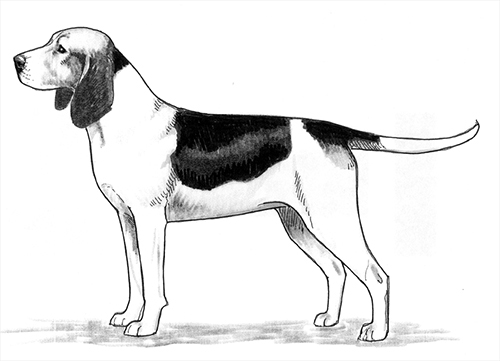Chien d’Artois
Scenthound Group
The goals and purposes of this breed standard include: to furnish guidelines for breeders who wish to maintain the quality of their breed and to improve it; to advance this breed to a state of similarity throughout the world; and to act as a guide for judges.
Breeders and judges have the responsibility to avoid any conditions or exaggerations that are detrimental to the health, welfare, essence and soundness of this breed, and must take the responsibility to see that these are not perpetuated.
Any departure from the following should be considered a fault, and the seriousness with which the fault should be regarded should be in exact proportion to its degree and its effect upon the health and welfare of the dog and on the dog’s ability to perform its traditional work.
History
Formerly named the Picard, the Chien d’Artois is an ancient French hunting breed that is widely used on deer, hare and wild boar. They generally hunt in a small pack of six to eight hounds. Following the Second World War, it was feared that the breed was one that had been lost, but in the early 1970’s the breed was reconstructed in its homeland.
The Chien d’Artois was recognized by the United Kennel Club in 2006.
General Appearance
A well constructed, muscular, medium sized, short coated scenthound breed.
Characteristics
Vigorous and hard, with a well developed nose, and a strong pack instinct.
Head
SKULL
Strong, broad, and not too long, the skull is rounded on top, but there is no prominence of occiput. The stop is accentuated.
MUZZLE
Slightly shorter than the skull, with a straight nasal bone. The upper lip covers the lower lip and forms a square profile.
TEETH
The Chien d’Artois has a complete set of evenly spaced, white teeth meeting in a scissors bite.
Disqualifications: Overshot or undershot bite.
NOSE
Strong and black, with well opened nostrils.
EYES
The eyes are set rather well apart. They are round in shape and dark brown in color. The expression is soft and melancholy.
Fault: Light eyes.
Disqualification: Yellow (hawk) eyes.
EARS
Set at eye level, broad at the base, and rounded at the tips. Nearly flat and quite long, reaching to the nose.
Faults: Low set, short or curled ears.
Neck
Moderately long and powerful, with little dewlap.
Forequarters
The shoulders are oblique and muscular.
FORELEGS
Strong and vertical. The length of the foreleg is one half the height at the withers.
Body
In proportion, the body is just slightly longer than tall. The chest is let down to the elbow, and the ribs are rounded. The back is broad and straight, and the loin is slightly arched. The croup inclines slightly. The flanks are full.
Hindquarters
HIND LEGS
The hind legs are straight and parallel when viewed from behind. There is moderate angulation at the hock, and the rear pasterns are short and vertical.
Feet
Oval in shape, with tight toes and black pads.
Tail
Strong and quite long, the tail is carried in sickle fashion. There is a brush on the underside of the tail.
Coat
Short, thick and flat.
Color
Dark fawn hound tricolor, similar to hare or badger, with a mantle or large patches. The head is usually fawn, sometimes with a black overlay.
Disqualification: Any color other than described.
Height and Weight
Height for males and females is between 21and 23 inches at the withers. Weight is from 62 to 66 pounds.
Gait
Even and easy.
Eliminating Faults
(An Eliminating Fault is a Fault serious enough that it eliminates the dog from obtaining any awards in a conformation event.)
Height over or under the accepted measurements.
Disqualifications
(A dog with a Disqualification must not be considered for placement in a conformation event, and must be reported to UKC.)
Unilateral or bilateral cryptorchid.
Viciousness or extreme shyness.
Albinism.
Overshot or undershot bite.
Yellow (hawk) eyes.
Any color other than described.

Looking for a Dog?
Find a dog that will fit your family.
Note: The breeders on this list are not endorsed by UKC.
Revised July 1, 2009
©Copyright 2006, United Kennel Club
